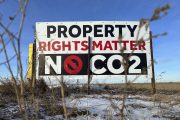
Climate alarmists such as California Governor Jerry Brown would like us to believe that global warming is causing (and worsening) the recent spate of wildfires in the Golden State. Unfortunately for Governor Brown, the facts and the science simply don’t line up with his opinion.
Wildfires are natural occurrences that have been happening since flora first appeared on the Earth. Scientists and others involved in land and forest management not only accept that such fires will happen as part of the natural ecosystem, they also see them as beneficial in certain ways. Wildfires occurring naturally reduce fuel loads such as downed trees, fallen limbs, brush, leaves and other combustible material. When fires burn naturally, they release nutrients into the soil which would otherwise be wasted in leaves and undergrowth.
Some habitats — such as the California Chaparral — actually depend on fire to a certain extent. Periodic fires burn off species of plants that are not native and less fire resistant, which gives the native species a leg up in the competition for space.
The wildfires currently ongoing in California are not due to global warming. They are a natural occurrence, the tragic aspects of which are caused, at least in part, by poor governmental decisions.
Tom McClintock, the Republican congressman from California’s 4th District, stated during a congressional hearing on wildfire prevention in May, “Forty-five years ago, we began imposing laws that have made the management of our forests all but impossible.”
McClintock is specifically referring to federal laws meant to protect at-risk species, such as the spotted owl, under the Endangered Species Act, as well as the National Environmental Policy Act. These federal laws prevent common-sense logging and scientific forestry methods in federal forests.
There are currently an estimated 66 million dead trees in the Sierra Nevada Mountain Range. The land there can comfortably support between 20 and 100 trees per acre. The current tree density in the area is 266 trees per acre. So not only are federal laws choking the area with dead trees, but the trees that remain must fight for space simply to survive.
The answer to this overcrowding used to be very simple. Private timber companies would contract with the federal government to come in and responsibly harvest the national forests. Excess trees were cut down and removed before they could become fuel for fire. It was a win-win for everyone. Certainly, such timber sales did not prevent fires, but it did make them less intense. But bureaucracy and overzealous environmental policy have made such timber sales cost-prohibitive and unpalatable to private timber concerns.
And it’s not just federal policy that exacerbates these fires. State, county, and local lawmakers bear partial responsibility for the horrific 2017 fire season. Mismanagement and a lack of foresight are major reasons that the recent California wildfires have been so catastrophic.
A large number of homes are built in areas that are extremely susceptible to wildfires — a direct result of irresponsible community planning. For instance, areas in California’s wildland urban interface (WUI) — an area where housing and vegetation (fuel) are extremely close together — have grown more than 300 percent in just the last 50 years. This poor planning places thousands in areas at high-risk for wildfires.
Local governments and counties also bear responsibility for a lack of proper planning and maintenance of electrical facilities such as power lines in these areas. Above ground electrical wires are very susceptible to arcing, especially in high gusts such as the Santa Anas in Southern California and the Diablo Winds in the central portion of the state. Such poor planning provides yet another source of ignition for fires.
The images from these fires are horrific. Giant swaths of land and homes are shown ablaze, the flames licking into the sky, the smoke blotting out the sun and causing extreme air condition issues. Valiant, tired, and soot-stained firefighters do their best, but watch in vain as the fires simply overwhelm them. These visions evoke an emotional response in people, which is perfect for climate alarmists to declare, “See! This is what happens with climate change!”
But now, with more than 40 people dead and billions of dollars’ worth of property destroyed, isn’t it time to look beyond the expedient political optics and find some common-sense solutions for these increasingly destructive wildfires?
Photo of California wildfire: AP Images





